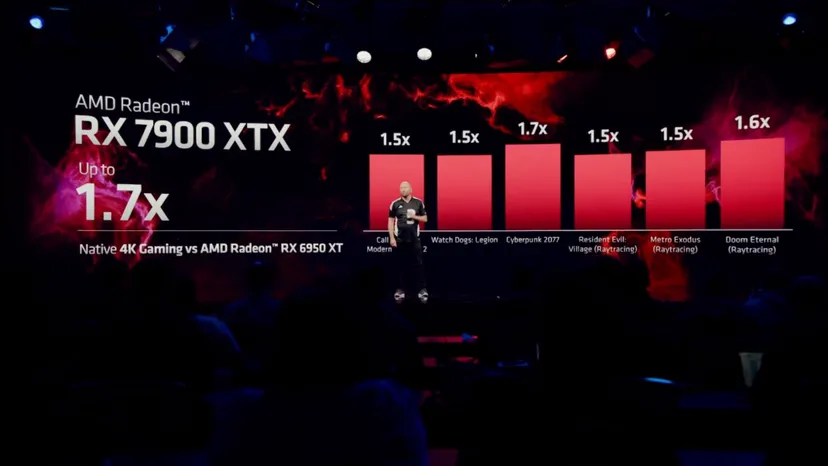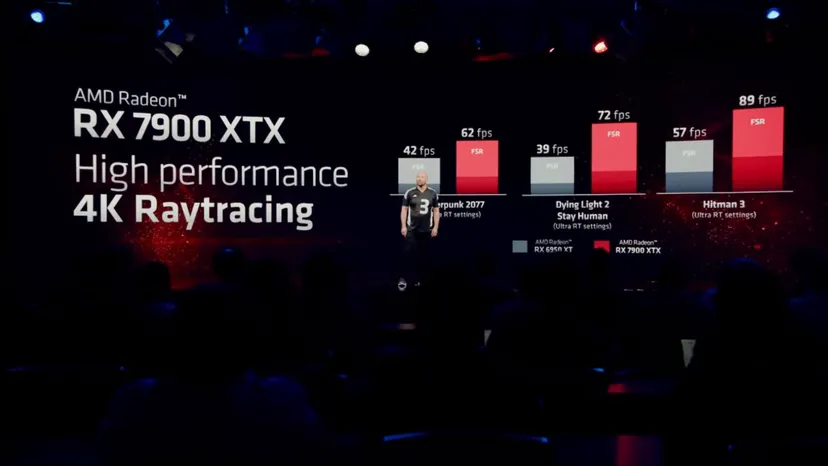The RX 7900 XTX and RX 7900 XT, the first graphics cards to be powered by AMD’s new RDNA 3 architecture, are part of the company’s next generation of graphics cards. That indicates that they have a chiplet design, like the business’ Ryzen processors.
Both AMD’s reference cards and board partner models are scheduled to ship on December 13th, the same day that both cards will go on sale. The 7900 XTX will cost $999, while the XT is priced at $899, saving $100. The top-spec 6950 XT retails for $849, while the base 6900 XT costs $679, despite the fact that they launched at $1,099 and $1,000, respectively. This is a considerable price increase compared to what the previous generation cards are now retailing for. However, the RTX 4080 from Nvidia starts at $1,199, while the 4090 costs a staggering $1,599.
People have been very interested in AMD’s next cards as they wait to see how it will counter Nvidia’s most recent RTX 4000 series GPUs, especially because Intel’s recently launched GPUs aren’t truly a high-end competitor.
The company’s flagship, the RX 7900 XTX, is advertised as being up to 1.7 times quicker than the RX 6950 XT card it currently offers for 4K gaming. It contains 24GB of GDDR6 memory and 96 compute units with a 2.3GHz clock speed. It also includes a 384-bit interface. Here, AMD seems to be primarily concerned about performance per watt. Though it consumes more power than Nvidia’s basic RTX 4080, AMD may have an efficiency advantage here with a board power of just 350 watts as opposed to the 450 watts on the RTX 4090.

The AMD Radeon RX 7900 XT is a less potent choice; it has 20GB of GDDR6 memory operating at a little slower 320 bits and 84 compute units running at 2GHz, along with a board power of 300W.
For both cards, the manufacturer claims that GDDR6 memory will be used instead of GDDR6X because it consumes less power. Both cards will need two common 8-pin connectors, so you won’t need to utilise any special connectors or adapters. For the 4090, Nvidia chose a new 12VHPWR connector, although there have been reports of those melting, a problem that the firm is still looking into.
RDNA 3 is expected to deliver up to a 54 percent increase in performance-per-watt over RDNA 2, which employed a more conventional GPU design, according to the company. Compared to RDNA 2, AMD claims to be able to produce up to 61 TFLOPs, although it’s important to keep in mind that these numbers aren’t necessarily comparable when discussing various architectures. As a result, it is unlikely that we will be able to compare the new PC GPUs from the firm directly to consoles like the PS5, Xbox Series, and Steam Deck that employ RDNA 2.
With its 7900 XTX card and AMD FidelityFX Super Resolution (FSR) enabled, AMD claims to achieve 62 frames per second in Cyberpunk 2077 at 4K. The company claims that its new compute units have next-generation ray-tracing technology, which provides an up to 50% performance boost over its last-gen cards. However, that is less than what the RTX 4090 has achieved at 4K with DLSS 2 or DLSS 3, therefore it appears that the 7900 XTX is better suited to compete with the RTX 4080 from Nvidia.

The story appears slightly better when rendered using classic rasterization, but we’ll have to wait and see how it works once we get our hands on it. AMD claims that the 7900 XTX can max out the frame rate limits of Apex Legends, Overwatch 2, and Valorant with 300, 600, and 833 fps, respectively, at “esports” (also known as medium-to-low) settings and 1440p resolution. At that time, it was mounted on an AM5 motherboard with a rather powerful system that included a Ryzen 9 7950X processor and 32GB of RAM.
While employing their FSR technology, which is comparable to Nvidia’s DLSS technology in that it renders games at a lower resolution and then upscales them, it claims that games like Call of Duty: Modern Warfare 2 can play at a frame rate of roughly 306 fps. When you upgrade to 8K, FSR does even more labor-intensive tasks for 96 frames per second in Assassin’s Creed Valhalla.
Also Read:




